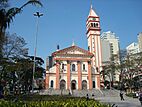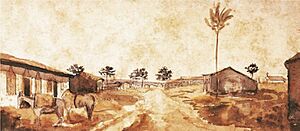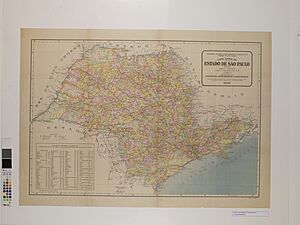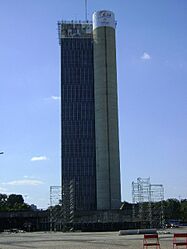São Bernardo do Campo facts for kids
Quick facts for kids
São Bernardo do Campo
|
|||
|---|---|---|---|
|
Municipality
|
|||
| Município de São Bernardo do Campo | |||
|
|
|||
|
|||
| Nickname(s):
The Automobile Capital
|
|||
| Motto(s):
Pavlistarvm Terra Mater
(Mother Land of the Paulistas) |
|||

Location in São Paulo
|
|||
| Country | |||
| Region | Southeast | ||
| State | |||
| Named for | Bernard of Clairvaux | ||
| Area | |||
| • Total | 409.51 km2 (158.11 sq mi) | ||
| Elevation | 762 m (2,500 ft) | ||
| Population
(2022)
|
|||
| • Total | 810,729 | ||
| • Density | 1,979.754/km2 (5,127.54/sq mi) | ||
| Postal Code |
09600-000
|
||
| Area code(s) | +55 11 | ||
| HDI (2010) | 0.805 – very high | ||
São Bernardo do Campo is a city in the state of São Paulo, Brazil. It is part of the larger Metropolitan Region of São Paulo. In 2022, about 810,729 people lived there.
This city is known as Brazil's "Automobile Capital." It has the 16th largest economy among all Brazilian cities.
Contents
- A Look Back in Time: The History of São Bernardo do Campo
- Exploring the Geography of São Bernardo do Campo
- People and Population of São Bernardo do Campo
- Economy: How São Bernardo do Campo Makes Money
- Education: Learning in São Bernardo do Campo
- Transportation: Getting Around São Bernardo do Campo
- Media: News and Communication
- Entertainment and Sports in São Bernardo do Campo
- Notable People from São Bernardo do Campo
- International Connections: Sister Cities
- Images for kids
- See also
A Look Back in Time: The History of São Bernardo do Campo
The city was started by João Ramalho in 1553. It was first called Vila de Santo André da Borda do Campo de Piratininga. This was one of the first Brazilian towns built away from the coast.
The original settlement was later renamed São Bernardo. It became a parish in 1812 and a city in 1890. In 1938, it joined the city of Santo André. But in 1945, it became its own city again. This happened thanks to a group of business people led by Wallace Cochrane Simonsen, who became the first mayor.
The area where São Bernardo do Campo is located was once a large farm. In the late 1800s, many European immigrants, especially from Italy, came to live here. They built small farms called colônias. Later, in the early 1900s, Japanese immigrants also arrived.
The Rise of Industry and Culture
In the 1960s, São Bernardo do Campo became famous for its metal industries. It earned the nickname "Automobile Capital" because many car factories opened there. Even though some factories have moved, the car industry is still a big part of the city's history. The city is also known for its furniture industry, started by Italian immigrants.
Many people from other parts of Brazil moved to São Bernardo in the 1960s for industrial jobs. One of them was the family of Luiz Inácio Lula da Silva, who later became the president of Brazil. He worked in car factories in the 1970s and became a well-known union leader.
São Bernardo also played a role in Brazilian movies. The Vera Cruz studios made many films there in the 1950s and 1960s. Famous football player Anderson Luís de Souza, known as Deco, was also born here.
Exploring the Geography of São Bernardo do Campo
Where is São Bernardo do Campo Located?
São Bernardo do Campo is located on top of the Serra do Mar mountain range. It sits on a high plateau. The city covers an area of about 407 square kilometers. The land goes from 60 meters above sea level to nearly 1,000 meters high at its highest point.
Understanding the Climate of São Bernardo do Campo
The city has a humid subtropical climate. This means it has warm, wet summers and mild, drier winters. The average temperature is around 19 degrees Celsius. In summer, temperatures can reach 34-35 degrees Celsius. Heavy storms can happen, bringing a lot of rain. Winters are cooler, with temperatures sometimes dropping to 8 degrees Celsius or less.
| Climate data for São Bernardo Do Campo, Brazil (1988–2008) | |||||||||||||
|---|---|---|---|---|---|---|---|---|---|---|---|---|---|
| Month | Jan | Feb | Mar | Apr | May | Jun | Jul | Aug | Sep | Oct | Nov | Dec | Year |
| Record high °C (°F) | 35.2 (95.4) |
35.2 (95.4) |
34.6 (94.3) |
33.1 (91.6) |
30.0 (86.0) |
27.6 (81.7) |
27.0 (80.6) |
30.4 (86.7) |
33.6 (92.5) |
35.4 (95.7) |
35.8 (96.4) |
35.0 (95.0) |
35.2 (95.4) |
| Mean daily maximum °C (°F) | 27.7 (81.9) |
27.5 (81.5) |
26.8 (80.2) |
24.9 (76.8) |
22.8 (73.0) |
20.8 (69.4) |
20.3 (68.5) |
22.2 (72.0) |
23.8 (74.8) |
24.7 (76.5) |
26.3 (79.3) |
27.6 (81.7) |
24.0 (75.2) |
| Mean daily minimum °C (°F) | 18.3 (64.9) |
18.4 (65.1) |
17.6 (63.7) |
15.6 (60.1) |
13.2 (55.8) |
10.9 (51.6) |
10.3 (50.5) |
11.4 (52.5) |
13.2 (55.8) |
14.6 (58.3) |
16.3 (61.3) |
18.1 (64.6) |
14.8 (58.6) |
| Record low °C (°F) | 13.0 (55.4) |
14.2 (57.6) |
11.0 (51.8) |
7.0 (44.6) |
3.0 (37.4) |
−2.0 (28.4) |
−3.6 (25.5) |
−3.0 (26.6) |
2.6 (36.7) |
6.4 (43.5) |
10.9 (51.6) |
12.6 (54.7) |
−3.6 (25.5) |
| Average precipitation mm (inches) | 240.3 (9.46) |
235.9 (9.29) |
176.3 (6.94) |
78.6 (3.09) |
76.3 (3.00) |
55.4 (2.18) |
53.3 (2.10) |
42.9 (1.69) |
89.5 (3.52) |
123.5 (4.86) |
155.6 (6.13) |
203.9 (8.03) |
1,424.5 (56.08) |
| Average relative humidity (%) | 77 | 74 | 70 | 67 | 66 | 63 | 61 | 56 | 63 | 66 | 69 | 74 | 67 |
| Source: CEPAGRI/UNICAMP (State University of Campinas's Centre for Meteorological and Climate Research Applied to Agriculture) | |||||||||||||
People and Population of São Bernardo do Campo
In 2006, the city had over 800,000 people. This made it the second most populated suburb of São Paulo. The population is a mix of different backgrounds.
| Color/Race | Percentage |
|---|---|
| White | 59.0% |
| Mixed | 32.3% |
| Black | 7.2% |
| Asian | 1.4% |
| Amerindian | 0.1% |
Source: 2022 census
Many people in São Bernardo do Campo have African and Portuguese roots. There are also many people with Italian, Arab, Asian (mostly Japanese), Spanish, and German family histories.
Economy: How São Bernardo do Campo Makes Money
Since the 1950s, São Bernardo do Campo's economy has been based on the auto industry. The Brazilian government encouraged car companies to build factories there. This led to many car and car parts factories opening in the city.
Big companies like Volkswagen, Mercedes-Benz, Ford Motor Co., and Scania built factories in São Bernardo do Campo. Other industries also grew, like paint companies and factories making products like toothpaste.
In the 1990s, the city's economy changed. The service sector, which includes things like shops and businesses, became more important. São Bernardo do Campo is also known as the "Furniture Capital" because of its many furniture stores. Recent years have seen a lot of new construction, especially for homes.
The city exports many goods, mostly transportation vehicles and machines. These include delivery trucks, tractors, car parts, and cars.
Education: Learning in São Bernardo do Campo
São Bernardo do Campo has many important universities and colleges. These include:
- Universidade Federal do ABC
- Faculdade de Tecnologia Termomecânica - FTT
- MEDICINA - Universidade Nove de Julho
- ETEC Lauro Gomes
- Faculdade SENAI de Tecnologia Ambiental
- Centro Universitário da FEI
- Faculdade de Tecnologia de São Bernardo do Campo - FATEC
- Faculdade PanAmérica - FAPAN
- Faculdade de São Bernardo do Campo
- Faculdade Anchieta
- Faculdade de Direito de São Bernardo do Campo
- UMESP - Universidade Metodista de São Paulo
- Seminário Presbiteriano Conservador
- Universidade Bandeirante de São Paulo - UNIBAN
- Faculdade Interação Americana - FIA
- ESPM - Centro de Estudos de Propaganda e Marketing LTDA.
- Colégio Termomecanica
Transportation: Getting Around São Bernardo do Campo
São Bernardo do Campo is a key part of the ABCD region. This region includes Santo André, São Bernardo do Campo, São Caetano do Sul, and Diadema.
Major Roads and Highways
Several important roads connect São Bernardo do Campo to other cities and ports:
- Via Anchieta (SP-150): This road connects São Paulo city to the Port of Santos. Many large factories are located along this road.
- Rodovia dos Imigrantes (SP-160): This highway also links São Paulo to the southern coast.
- Perito Criminal Eng. Antonio Carlos Moraes/Interligação do Planalto (SP-041): A short road that connects Via Anchieta and Rodovia dos Imigrantes.
- Rodovia Índio Tibiriçá (SP-031): Connects São Bernardo do Campo to the city of Suzano.
- Caminho do Mar (SP-148): A historic road that once connected the city to Cubatão and the port. Today, it's mostly used for local access.
- Rodoanel Mário Covas (SP-021): A large ring road that goes around the Metropolitan Region of São Paulo. It helps trucks avoid driving through the busy city center.
Public Transport Options
Public transportation is managed by ETCSBC and EMTU.
- Local Buses: SBCTrans operates bus and minibus services within the city.
- Intercity Buses: Buses connect São Bernardo do Campo to nearby cities like Diadema, Santo André, and São Paulo.
- Trolleybus System: The Corredor São Mateus-Jabaquara is a special bus system that uses electric trolleybuses. It connects São Bernardo do Campo to other cities and the São Paulo Metro.
The city also has several bus terminals where you can catch local, intercity, and long-distance buses to other states in Brazil.
Media: News and Communication
São Bernardo do Campo has many small local newspapers. The Diário do Grande ABC is a daily newspaper that covers the entire ABC region.
For phones and internet, the city was served by a company called Companhia Telefônica da Borda do Campo. This company was later bought by Telefónica and now operates under the Vivo brand, offering cell phones, landlines, internet, and TV services.
Entertainment and Sports in São Bernardo do Campo
The Cidade da Criança (Children's City) is an amusement park in the city center. It was the first theme park in Brazil and Latin America, opening in 1968.
The city has two rival association football clubs: São Bernardo Futebol Clube and Esporte Clube São Bernardo. São Bernardo do Campo has also hosted international handball championships.
The city also has an American Football team called the São Bernardo Avengers. They have won local championships and compete in national leagues.
Notable People from São Bernardo do Campo
Many well-known people come from São Bernardo do Campo, including:
- Salvador Arena (1915–1998), a famous Brazilian business person.
- Deco (born 1977), a football player.
- Gabigol (born 1996), a football player.
- Hugo Hoyama (born 1969), a retired table tennis player.
- Andreas Kisser (born 1968), a guitarist.
- Thiago Motta (born 1982), a football player.
- Alex "Poatan" Pereira, a mixed martial artist and UFC champion.
- Maisa Silva (born 2002), an actress.
- Bruna Takahashi (born 2000), a table tennis player.
International Connections: Sister Cities
São Bernardo do Campo has "sister city" relationships with many cities around the world. These connections help promote cultural exchange and friendship.
|
Images for kids
See also
 In Spanish: São Bernardo do Campo para niños
In Spanish: São Bernardo do Campo para niños















